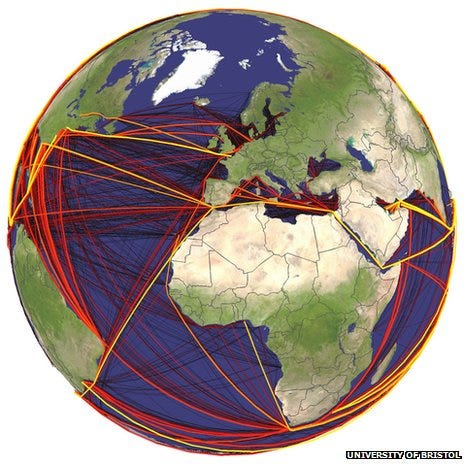The ecology of the connected world
For the entirety of human history, through curiosity, commerce, and conquest, the world has become an ever more connected place. This trendline, plus the end of the Cold War triumphalism embodied in Francis Fukuyama’s The End of History, reached a pop-culture apogee with Jules and Vincent’s iconic conversation about the Royale with Cheese. Although the peaceful global strip mall of a new world order never quite came to pass neither has the degree of globalization diminished since the fall of the Berlin wall.
Thousands of years of the history of commerce, from the Phoenicians, through the Silk Road, can let us do some neat stuff like covering ourselves in Hello Kitty paraphernalia at a duty-free shop in Dubai. Although, if humans were to vanish tomorrow the enduring legacy of our centuries of activity would not show up in this cosmopolitan bric-a-brac, but rather in the fossil record and the geographic distribution of species. For every good intentionally traded there was at least one species along for the ride.
The idea of invasive, or non-native species, is well established in both ecology and popular culture. Their introduction is sometimes deliberate, but is more often an inadvertent byproduct of shipping organisms in the hold or ballast water of the thousands of ocean going vessels involved in global commerce. Most people know of at least one example, such as kudzu in the American south or cane toads in Australia.
These are, at least from the perspective of the introduced species, the success stories. Many organisms have hitched rides in cargo holds only to find an inhospitable climate, no food, or that they’re incredibly delicious to something just beyond the docks. Although predicting which introduced species will become invasive is not entirely possible, for a number of species, the odds are stacked in their favor.
Witness the cockroach, pigeon, and rat. What these species have in common is their ability to fit into ecosystem of cities. For humans every city may be distinctive, but in aggregate they form a type of biome that is generally warmer, wetter, brighter, and with more food sources than the surrounding environment. Just as the world has temperate rainforests, chaparral, and taiga it now has an archipelago of urban biomes connected by the filaments of trade and travel.

The question then is what will happen to local and global levels of biodiversity as cities grow in scale and our species drifts towards near 100% levels of urbanization. It is well established that local species will be displaced or killed off as a city expands and foreign species are introduced. Though will this biological era, dubbed by some ecologists as the anthropocene, lead to a Fukuyama-esque end of biological history: a repetitive global strip mall ecosystem? Or, as with international relations in the 1990s, witnessing an equivalent lull following the collapse of an earlier dynamic?
What would be interesting to see is if each city acts like an island, leading to a burst of speciation in the local environment, or if urban areas cause a collapse in the general level of biodiversity. In testing this question we may be able to compare current and historical trends relating the degree of globalization for a city, how interconnected it is with other cities, as well as the density and diversity of species within the urban area as well as its vicinity. Testing long term causal relations may be far more difficult, but if cities have an impact on local and global biodiversity today then it stands to reason they have had it for centuries. In which case a study would benefit from looking at measures of biodiversity in and around urban environments as trade networks grew and collapsed over the years. Of course this would be an even more difficult undertaking than trying to study any current relationships.
What data sets currently exist, or methodologies for measuring current and historical biodiversity, which could help address this question?
Comments and questions welcome at levisimons@gmail.com .
(Originally published here on December 14th 2015)

Comments
Post a Comment